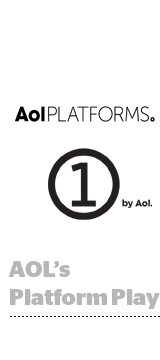 AOL Networks on Wednesday rebranded as AOL Platforms.
AOL Networks on Wednesday rebranded as AOL Platforms.
As part of the rebrand, the company has rolled programmatic capabilities for video with Adap.tv, mobile and display with the AdLearn Open Platform (AOP) and its supply-side Marketplace product, into the development of platform “ONE by AOL.” IPG Mediabrands is the charter agency partner for ONE, which will aid with agency activation of data across display, mobile, video and linear TV.
“If you fast forward two to three years from now, you’re not going to see an ecosystem where there’s four layers between the buyer and seller,” explained Amir Ashkenazi, CEO of programmatic video platform Adap.tv, acquired by AOL last fall. “Companies that can develop a comprehensive, unified cross-device and cross-format solution will win.”
Additionally, ditching “Networks” – and its media connotations – may help AOL dispel concerns on the buy side that AOL’s ad tech arsenal is primarily a way to funnel demand to AOL-owned inventory.
AOL is betting on the benefits of the “network effect,” which Seth Demsey, chief technology officer of AOL Platforms, said is the opposite of “boxing” somebody into the use of a single product or media choice.
“When you enable [the marketer] with a platform, you can help them modify, build and evolve the platform to suit their needs,” he said. “It’s necessary that platforms work and be open to other technologies and data. The second thing is, when you create a platform, other people can extend the platform and make it more powerful in certain areas.”
He cites AOL’s recent acquisition of content-optimization software company Gravity as an example. Gravity, which has user modeling and interest graph technology baked in, “benefits from the data that AOL Platforms has, and has a lot to say back to AOL in terms of users, which can be used for targeting media contextually as well as optimizing the types of content people see,” he said.
This, primarily, has been the result of integrating engineering teams within Platforms products. One example is applying Gravity’s content optimization capabilities to the array of premium content available in video ad and content delivery platform AOL On.
Although early, the integration of Gravity accelerates work AOL has completed with Pictela, the rich media tool it acquired in 2010; Pictela is the cross-screen, responsive creative platform that AOL Platforms has applied to enrich mobile and display ad units and is now being groomed for video placements as part of ONE, Demsey said.
While ONE is open to other third-party creative software, infusing the Pictela product with AOL datasets and optimizing to the customer’s prior exposure in the funnel “not only helps us determine who [should see an ad], and when, and where, and how much to pay for it, but also what messages and what sequences do we send them in a comprehensive platform,” Demsey added.
Creative is one of the “unsung heroes” in AOL’s programmatic arsenal, he said.
In addition to the work AOL is doing with Pictela and Gravity, AOL’s 2012 acquisition of dynamic retargeting solution Buysight brought key engineering talent to the AOL Networks unit. The product, ultimately rebranded as Ad.com Dynamic Retargeter, enables broad-based optimization of content on a per-user segment basis.
Cleary AOL’s ONE is not an all-in-one solution for most agencies and advertisers, who still tap one or two point products such as Adap.tv or AOP in isolation at present. But AOL hopes that over time it can sell marketers on the value of a solution that unify campaign messaging for cross-device consumers.
“Today advertisers are forced to use multiple platforms that work in data silos,” Ashkenazi said. “They’re not sharing data or interact at all. On the desk right now, you probably have three or four screens, and to the advertiser, you’re four different people. It’s a source of inefficiency that is truly a challenge for brand advertisers. What we want to do is bring real meaning to the word ‘campaign.’”
Update: Onstage Wednesday at the ad:tech show in San Francisco, AOL Chairman and CEO Tim Armstrong addressed a problem still plaguing the ad industry – manual workflows. Despite the advancements made in programmatic media buying, “I was horrified by how many faxes [still] come in to AOL. Many of the things we’re doing today as an industry are done on manual processes.”
But, as Matt Seiler, global CEO of agency holding company IPG Mediabrands, pointed out – ridding the space of laborious processes won’t fall squarely on the buy side. “You can’t buy through automation unless people are selling that way,” he said.
Touching on programmatic headway the agency has made through its MAGNA Consortium initiative, Seiler said there is a key misconception that continues to surface on the road to automating media and data assets cross-platform. One of the perceived challenges around automating the TV buy is a subsequent decrease in the value of that inventory.
“We went to one of the large broadcasters and asked if they’d be interested in joining, and [the CEO] said, ‘What youre talking about is right, but not on my watch.’ We have cable operators, content providers and every mix of the marketing model represented through the consortium. They will benefit first from having raised their hands and said, ‘It’s time to change.’ I think we can drive that ridiculous inefficiency that is our business – out.”














